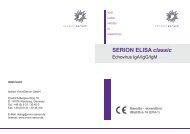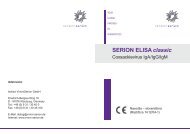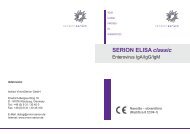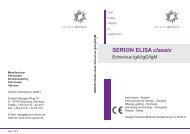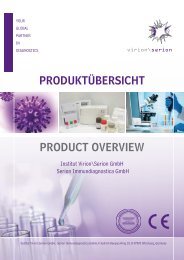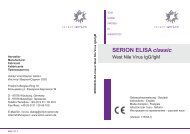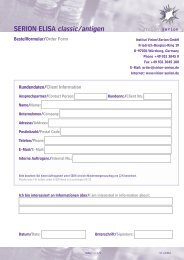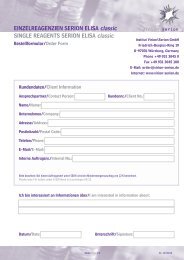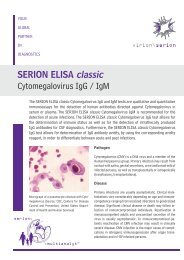SERION ELISA classic Bordetella pertussis IgA / IgG ... - virion\serion
SERION ELISA classic Bordetella pertussis IgA / IgG ... - virion\serion
SERION ELISA classic Bordetella pertussis IgA / IgG ... - virion\serion
You also want an ePaper? Increase the reach of your titles
YUMPU automatically turns print PDFs into web optimized ePapers that Google loves.
YOUR<br />
GLOBAL<br />
PARTNER<br />
IN<br />
DIAGNOSTICS<br />
<strong>SERION</strong> <strong>ELISA</strong> <strong>classic</strong><br />
<strong>Bordetella</strong> <strong>pertussis</strong> <strong>IgA</strong> / <strong>IgG</strong> / IgM<br />
serion<br />
The <strong>SERION</strong> <strong>ELISA</strong> <strong>classic</strong> <strong>Bordetella</strong> <strong>pertussis</strong> <strong>IgA</strong>, <strong>IgG</strong> and IgM tests are qualitative and<br />
quantitative immunoassays for the detection of human antibodies in serum or plasma directed<br />
against <strong>Bordetella</strong> <strong>pertussis</strong> and <strong>Bordetella</strong> para<strong>pertussis</strong> for the laboratory confirmation<br />
of whooping cough. The differential detection of individual antibody classes supports the<br />
categorization of the disease stage.<br />
Electron micrograph of bacteria of genus <strong>Bordetella</strong><br />
(Source: Centers for Disease Control and<br />
Prevention, United States Department of Health<br />
and Human Services)<br />
multianalyt TM<br />
Pathogen<br />
<strong>Bordetella</strong> <strong>pertussis</strong> and <strong>Bordetella</strong> para<strong>pertussis</strong> are<br />
pathogens responsible for whooping cough, a worldwide<br />
spread infectious disease that is transmitted from person to<br />
person by droplet infection. Particularily children up to four<br />
years old are affected and the mortality in infected infants<br />
is high. Although young people and adults usually do not get<br />
seriously ill, they are a risk as a source of infection for non<br />
protected and risk patients such as infants, old and ill people.<br />
Colonization of the respiratory tract and establishment of<br />
infection are facilitated by the synergistic action of several<br />
virulence factors.<br />
Disease<br />
Progression of typical whooping cough can be divided into<br />
three stages. After an incubation period of one to two weeks<br />
symptoms begin with the catarrhal phase, usually accompanied<br />
by a cough, rhinitis and conjunctivitis. Subsequently,<br />
the convulsive phase follows characterized by paroxysmal<br />
cough attacks combined with vomiting of viscid mucus,<br />
laryngospasm and bronchospasm, leading to a blue-cyanozed<br />
complexion in the child. After four to six weeks attacks<br />
diminish and slowly subside in the decrementi phase.
Diagnosis<br />
The <strong>ELISA</strong> technique is the most commonly chosen method<br />
for B. <strong>pertussis</strong> specific antibody detection in serodiagnosis<br />
and complements direct antigen detection. In over 90 %<br />
of cases the <strong>IgG</strong> and <strong>IgA</strong> antibody responses are directed<br />
against the immunogens PT and FHA. Therefore, the <strong>SERION</strong><br />
<strong>ELISA</strong> <strong>classic</strong> <strong>Bordetella</strong> <strong>pertussis</strong> <strong>IgG</strong> and <strong>IgA</strong> tests are<br />
based on antigen mixtures of PT and FHA. For the detection<br />
of IgM antibodies cellular bound lipopolysaccharid has outstanding<br />
diagnostic properties. Consequently, a whole-cell<br />
antigen preparation of B. <strong>pertussis</strong> is used in the <strong>SERION</strong><br />
<strong>ELISA</strong> <strong>classic</strong> <strong>Bordetella</strong> <strong>pertussis</strong> IgM.<br />
<strong>SERION</strong> <strong>ELISA</strong> <strong>classic</strong> <strong>Bordetella</strong> <strong>pertussis</strong><br />
The performance characteristics of the <strong>SERION</strong> <strong>ELISA</strong> <strong>classic</strong><br />
<strong>Bordetella</strong> <strong>pertussis</strong> <strong>IgA</strong> (<strong>IgG</strong>) test were assessed by<br />
the analysis of 72 (69) specimens including serum samples<br />
from patients with suspected infection of <strong>Bordetella</strong> <strong>pertussis</strong><br />
or <strong>Bordetella</strong> para<strong>pertussis</strong>, from healthy blood donors,<br />
samples from interlaboratory tests as well as the two international<br />
standard preparations of the World Health Organization<br />
(WHO) 06/140 and 06/142. Three <strong>ELISA</strong> and an immunoblot<br />
of leading European manufacturers were used as<br />
references.<br />
Highlights of <strong>SERION</strong> <strong>ELISA</strong> <strong>classic</strong> <strong>Bordetella</strong> <strong>pertussis</strong> <strong>IgA</strong>/<strong>IgG</strong>/IgM<br />
● Use of a mixture of Pertussis Toxin (PT) and Filamentous Hemagglutinin (FHA) for the<br />
demonstration of <strong>IgA</strong> and <strong>IgG</strong> antibodies against <strong>Bordetella</strong> <strong>pertussis</strong> and <strong>Bordetella</strong> para<strong>pertussis</strong><br />
for the laboratory confirmation of whooping cough<br />
● Use of membrane-bound lipopolysaccharide (LPS) for the demonstration of IgM antibodies<br />
for diagnosis of acute primary infections, particularly in children<br />
● Quantification of antibody activities by using the precise and cost-efficient single-point calibration<br />
Order Information<br />
<strong>SERION</strong> <strong>ELISA</strong> <strong>classic</strong> <strong>Bordetella</strong> <strong>pertussis</strong> <strong>IgA</strong> Order Nr.: ESR 120 A<br />
<strong>SERION</strong> <strong>ELISA</strong> <strong>classic</strong> <strong>Bordetella</strong> <strong>pertussis</strong> <strong>IgG</strong> Order Nr.: ESR 120 G<br />
<strong>SERION</strong> <strong>ELISA</strong> <strong>classic</strong> <strong>Bordetella</strong> <strong>pertussis</strong> IgM Order Nr.: ESR 120 M<br />
<strong>SERION</strong> <strong>ELISA</strong> control <strong>Bordetella</strong> <strong>pertussis</strong> <strong>IgA</strong> Order Nr.: C 120 A<br />
<strong>SERION</strong> <strong>ELISA</strong> control <strong>Bordetella</strong> <strong>pertussis</strong> <strong>IgG</strong> Order Nr.: C 120 G<br />
Please visit our website www.virion-serion.com for more information on our <strong>SERION</strong> <strong>ELISA</strong> <strong>classic</strong> products.<br />
Institut Virion\Serion GmbH<br />
Serion Immundiagnostica GmbH<br />
Friedrich-Bergius-Ring 19<br />
97076 Würzburg, Germany<br />
The <strong>SERION</strong> <strong>ELISA</strong> <strong>classic</strong> <strong>Bordetella</strong> <strong>pertussis</strong> IgM test was<br />
validated in an external study by the analysis of 86 serum<br />
samples in comparison to a commercially available test.<br />
<strong>SERION</strong> <strong>ELISA</strong> <strong>classic</strong> Sensitivity Specificity<br />
<strong>Bordetella</strong> <strong>pertussis</strong> <strong>IgA</strong> > 99 % > 99 %<br />
<strong>Bordetella</strong> <strong>pertussis</strong> <strong>IgG</strong> > 99 % > 99 %<br />
<strong>Bordetella</strong> <strong>pertussis</strong> IgM 80.0 % > 99 %<br />
Precision<br />
<strong>SERION</strong> <strong>ELISA</strong> <strong>classic</strong> <strong>Bordetella</strong> <strong>pertussis</strong> <strong>IgA</strong><br />
Sample Mean<br />
value<br />
OD<br />
Intraassay<br />
CV (%)<br />
(n=20)<br />
Tel.: +49 (0)931 3045-222<br />
Fax: +49 (0)931 3045-100<br />
dialog@virion-serion.de<br />
www.virion-serion.com<br />
Mean<br />
value<br />
OD<br />
Interassay<br />
CV (%)<br />
(n=10)<br />
negative 0.480 7.9 0.563 7.4<br />
positive 1.827 4.1 2.022 3.6<br />
positive 2.008 6.0 2.177 4.2<br />
<strong>SERION</strong> <strong>ELISA</strong> <strong>classic</strong> <strong>Bordetella</strong> <strong>pertussis</strong> <strong>IgG</strong><br />
Sample Mean<br />
value<br />
OD<br />
Intraassay<br />
CV (%)<br />
(n=20)<br />
Mean<br />
value<br />
OD<br />
Interassay<br />
CV (%)<br />
(n=10)<br />
negative 0.397 5.4 0.446 12.4<br />
positive 1.133 3.4 1.188 7.3<br />
positive 1.786 1.6 1.806 4.4<br />
Institut Virion\Serion GmbH, V3.12/08





